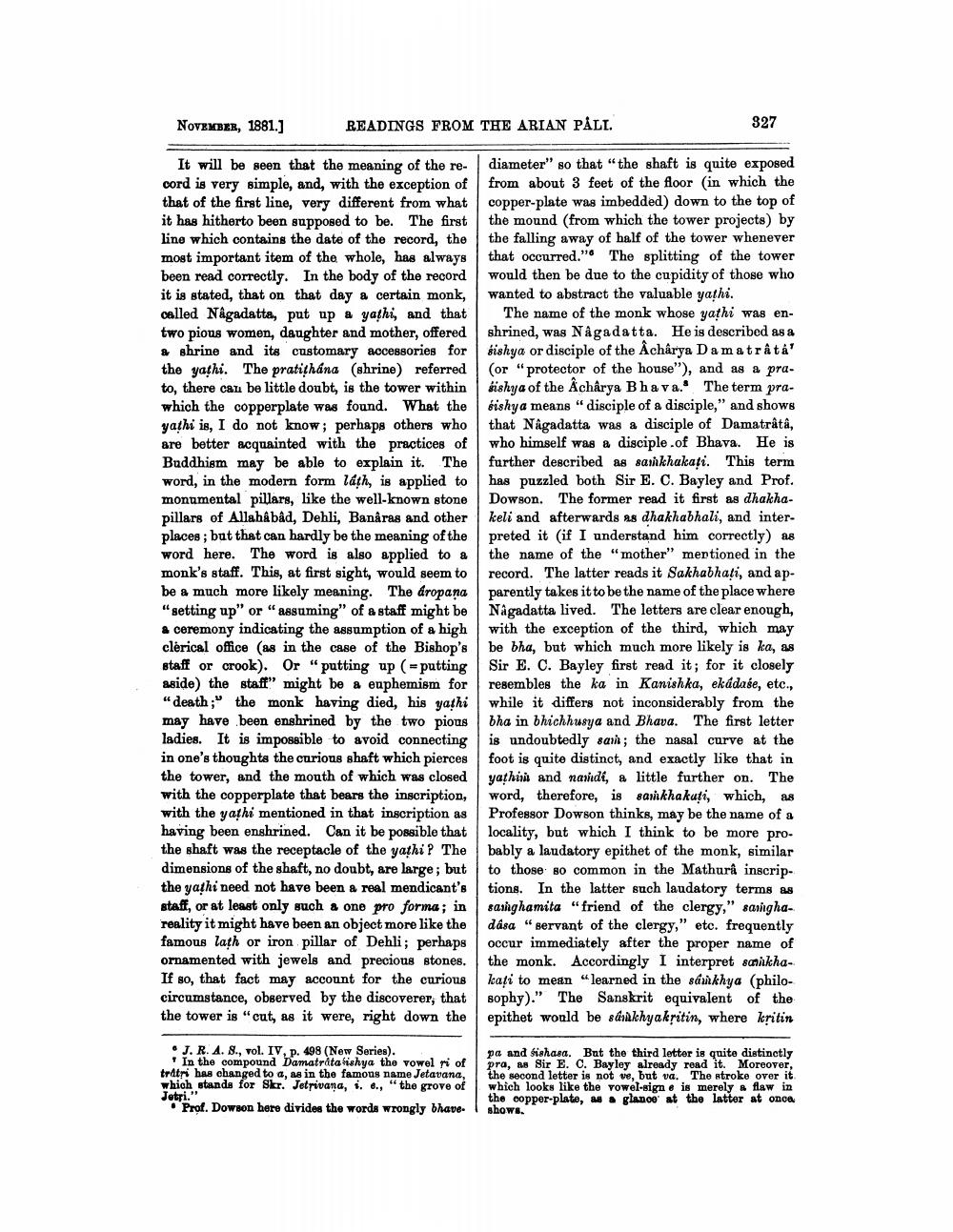________________
NOVEMBER, 1881.)
READINGS FROM THE ARIAN PÅLI.
327
It will be seen that the meaning of the re- diameter" so that "the shaft is quite exposed cord is very simple, and, with the exception of from about 3 feet of the floor (in which the that of the first line, very different from what copper-plate was imbedded) down to the top of it has hitherto been supposed to be. The first the mound (from which the tower projects) by line which contains the date of the record, the the falling away of half of the tower whenever most important item of the whole, has always that occurred." The splitting of the tower been read correctly. In the body of the record would then be due to the cupidity of those who it is stated, that on that day a certain monk, wanted to abstract the valuable yathi. called Någadatta, put up a yathi, and that The name of the monk whose yathi was entwo pious women, daughter and mother, offered shrined, was Någadatta. He is described as a & shrine and its customary accessories for sishya or disciple of the Acharya Damatråta' the yathi. The pratithana (shrine) referred (or "protector of the house"), and as a prato, there can be little doubt, is the tower within fishya of the Acharya Bhava." The term prawhich the copperplate was found. What the sishya means "disciple of a disciple," and shows yathi is, I do not know; perhaps others who that Nagadatta was a disciple of Damatratâ, are better acquainted with the practices of who himself was a disciple.of Bhava. He is Buddhism may be able to explain it. The further described as satikhakați. This term word, in the modern form láth, is applied to has puzzled both Sir E. C. Bayley and Prof. monumental pillars, like the well-known stone Dowson. The former read it first as dhakhapillars of Allahâbâd, Dehli, Banaras and other keli and afterwards as dhakhabhali, and interplaces ; but that can hardly be the meaning of the preted it (if I understand him correctly) as word here. The word is also applied to a the name of the "mother" mentioned in the monk's staff. This, at first sight, would seem to record. The latter reads it Sakhabhati, and apbe a much more likely meaning. The dropana parently takes it to be the name of the place where "setting up" or "assuming" of a staff might be a ceremony indicating the assumption of a high with the exception of the third, which may clerical office (as in the case of the Bishop's be bha, but which much more likely is ka, as staff or crook). Or "putting up (= putting Sir E. C. Bayley first read it; for it closely aside) the staff" might be a euphemism for resembles the ka in Kanishka, ekádase, etc., « death ;u the monk having died, his yathi while it differs not inconsiderably from the may have been enshrined by the two pious bha in bhichhusya and Bhava. The first letter ladies. It is impossible to avoid connecting is undoubtedly sar; the nasal curve at the in one's thoughts the curious shaft which pierces foot is quite distinct, and exactly like that in the tower, and the mouth of which was closed yathi and naridi, a little further on. The with the copperplate that bears the inscription, word, therefore, is sankhakuti, which, as with the yathi mentioned in that inscription as Professor Dowson thinks, may be the name of a having been enshrined. Can it be possible that locality, but which I think to be more prothe shaft was the receptacle of the yathi ? The bably a laudatory epithet of the monk, similar dimensions of the shaft, no doubt, are large; but to those so common in the Mathuri inscripthe yathi need not have been a real mendicant's tions. In the latter such laudatory terms as staff, or at least only such a one pro forma; insanghamita "friend of the clergy," sainghareality it might have been an object more like the dása “servant of the clergy," etc. frequently famous lath or iron pillar of Dehli; perhaps occur immediately after the proper name of ornamented with jewels and precious stones. the monk. Accordingly I interpret saikha. If so, that fact may account for the curious kati to mean "learned in the sámkhya (philocircumstance, observed by the discoverer, that sophy)." The Sanskrit equivalent of the the tower is "cut, as it were, right down the epithet would be sánhkhyakritin, where kritin
• J. R. A. 8., vol. IV, p. 498 (New Series).
In the compound Damatrata Fishya the vowel ri of tratri has changed to a, as in the famous name Jetavana, which stands for Skr. Jetsivana, 1. e., "the grove of Jetri."
Prof. Dowson here divides the words wrongly bhave
pa and fishasa. But the third letter is quite distinctly pra, as Sir E. O. Bayley already read it. Moreover, the second letter is not ve, but va. The stroke over it which looks like the vowel-sign e is merely a flaw in the copper-plate, as a glance at the latter at onoa shows.




